Synonymous with machinery for harvesting grass and cereals for many years, Claas has been making solid inroads into the tractor business, particularly over the course of the past decade.
This stemmed from a move in February 2003, over 20 years ago, when Helmut Claas signed an agreement which saw Claas acquire the Renault Agriculture tractor brand.
Since then, the company has progressed in leaps and bounds, building in the region of 220,000 tractors including its Xerion range. Today, the firm manufactures up to 75 tractors daily, across 105 models from 75hp to 460hp at the Le Mans plant in France. These tractors are exported to over 80 countries worldwide, meaning Claas is becoming a big player in the market.

With 264hp neatly tucked away under the one-piece bonnet, the 850 sources power from a six-pot, 6.7l FPT engine.
Within the past few years, competition in the high horsepower tractor market has really heated up. We have seen complete revamps and new variations from a whole host of manufacturers, whether it be the new Fendt 700 series, John Deere’s 6R and 7R, Massey Ferguson’s 8S, Valtra’s Q Series, JCB’s iCON, Case IH’s Puma 260 CVX Drive or New Holland’s new T7.300 to name but a few. Keen to showcase its latest wares, Claas offered us the opportunity to get behind the wheel of a top spec Claas Axion 850 Cmatic over the summer months.
The 850 sources power from a six-pot, 6.7 litre FPT (Fiat Powertrain Technologies) NEF 6 engine. With 264hp neatly tucked away under the one-piece bonnet, the engine meets the Stage V emission standards by incorporating exhaust gas aftertreatment with AdBlue. The engine uses common rail four-valve technology, charge-air cooling and a variable geometry turbo (VGT). Claas claims that the VGT turbo adjusts to load and engine speed, making 70% of maximum torque available when idling.
Axion engine oil service intervals have now gone to 600 operating hours, while transmission and hydraulic oil intervals have been extended to 1,200 hours. Key maintenance points across the tractor seem to be quite easily accessible. The hood opens up high, allowing easy access to the engine compartment. The cooling pack opens out in a two-stage folding process, making it easy for the operator to thoroughly blow out around the radiator.

The combination of the engine and the CVT transmission in sync offered responsive and powerful acceleration and smooth deceleration.
In transport work, the engine felt very responsive. The tractor pulled away heavy loads, pushing to a top speed of 56km/h very quickly, while making very little fuss. In fact, top speed is hit at an engine speed of just 1,600 rpm, while 40 km/h is achieved at 1,300 rpm.
The combination of the engine and the continuously variable transmission (CVT) in sync offered responsive and powerful acceleration and smooth deceleration. The engine wasn’t left wanting power, and torque seemed to be on hand at low engine rpm.
Cmatic is the name Claas uses for the CVT used in its tractor ranges. In its Arion 500 and 600 Cmatic tractor series, the German manufacturer uses its own in-house manufactured EQ (EQ 200 and EQ 220) stepless transmissions. In the larger Axion 800 series we tried, the firm uses a ZF Terramatic transmission. However, it is believed that a larger stepless transmission is in development in-house and it is only a matter of time before it’s unveiled.
With the ZF transmission, the hydraulic mechanical split-power CVT features four mechanical ranges that are automatically selected by multidisc clutches. This means there is no need to shift between ranges manually, as it’s selected automatically each time.
The transmission has three working modes – the accelerator pedal, the drive lever and manual mode. In the first two modes, forward speed can be controlled by the accelerator pedal or drive lever. The engine speed and transmission ratio are adjusted automatically. In manual mode, it’s up to the driver to choose the engine speed and transmission ratio.
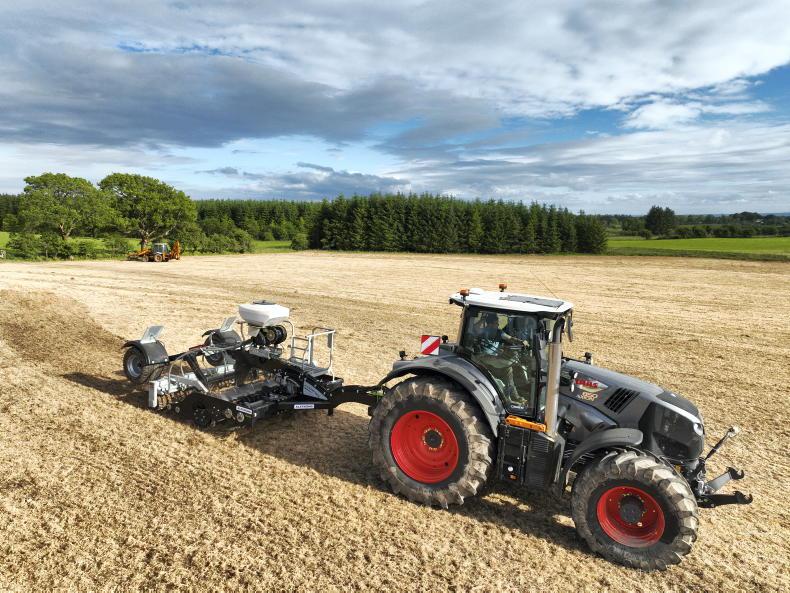
This particular tractor is fitted with the manufacturers ‘Special Operation Centre’ package, which is a special order from factory.

The 850 we put through her paces was spec’d with the largest 205 l/min pump available.
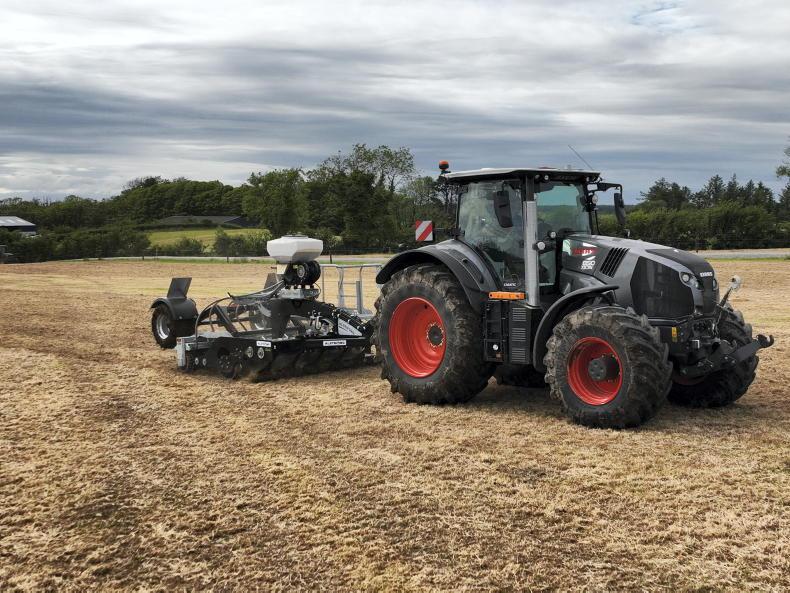
The biggest thing that took us by surprise with the tractor was the level of configuration available, and the ease of carrying out this configuration through the touchscreen Cebis terminal.
The transmission has three speed ranges, each of which can be pre-selected in both directions of travel. Operators can very easily set upper preset speed restrictions within each range. This is very simply done, by just touching the speeds on the terminal and increasing/decreasing to the desired target. The active range is then displayed on the Cebis terminal in green, while the other two ranges sit in the background in grey. The ranges can then be changed while the tractor is on the go.
A cruise control option on the transmission allows speeds to be saved for all the ranges while on the move, by simply pressing a button on the drive lever. The cruise control speeds can be easily pre-set. Drivers can also create their own profiles according to the job in hand.
Again, through the terminal, operators can easily make adjustments to the engine droop value. It can be used for easy regulation of the engine speed under load. The Cebis terminal displays the engine speed at which the transmission reduces the speed. For work such as PTO applications where a constant engine speed is activated, the operator can specify different droop settings, usually one that matches the engine speed to the required PTO speed. Two engine droop values can be saved and retrieved. 
The ease of tweaking the transmission through the Cebis terminal to get the most out of the tractor and implement at hand really impressed us.
Customising the transmission
This was our first time properly getting to grips with the Claas Cmatic CVT system. It took a few hours to get used to it at first, but once accustomed, we were seriously impressed. You could literally jump on and drive after a few hours. Although the level of customization Claas offers is now almost expected among CVT buyers, it was the ease of tweaking the transmission to get the most out of the tractor and implement at hand that really impressed us. All modifications are at your fingertips, and are very easily and quickly performed through a small sequence of steps.
Claas are pushing several aspects of this transmission. Firstly, because all mechanical range changes happen automatically, with no operator input. This means the operator is safe in the knowledge that no matter the speed, the transmission will select the correct range itself.
To back up this statement, the manufacturer is now offering a 4,000-hour or four-year warranty on all 800 series Axions sold with a Cmatic transmission.
CVTs are known to be slightly more power hungry, but manufacturers will tell you this is made up for with the transmissions’ increased efficiency. Claas claims its offering always maintains a 60% mechanical drive from the transmission, meaning a maximum of 40% is sourced from the hydraulic aspect. This is important, as mechanical drive offers a better efficiency. 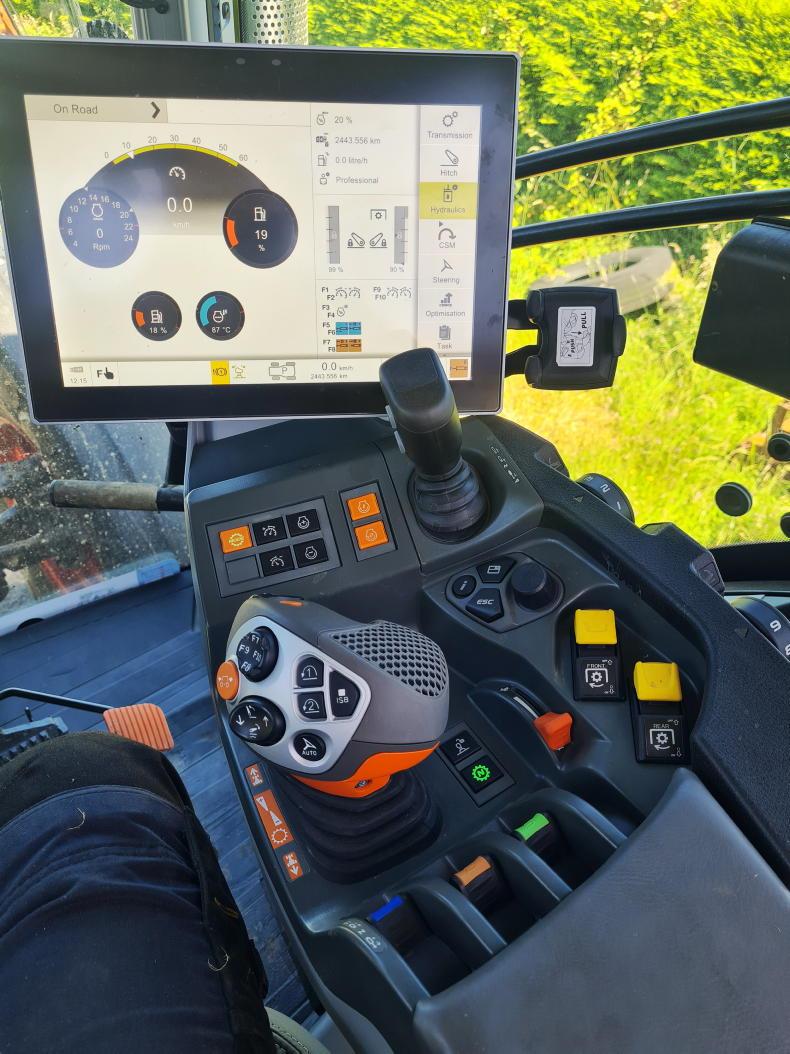
The tractor featured the Cebis controls, which includes the multifunction control lever and the 12" touchscreen terminal.
The 850 we put through her paces was spec’d with the largest 205 l/min pump available. All Axion 800 models come with the option of 110, 150 or 205 l/min output, all with load-sensing hydraulics. The pump provided ample hydraulics and was never left wanting from any task we tried it at.
Our tractor had six electronic spools, five on the rear and one on the front. On the Cebis terminal, up to seven electronic spool valves (front/rear combined) can be specified on the armrest, four of which can be operated by the Electropilot joystick.
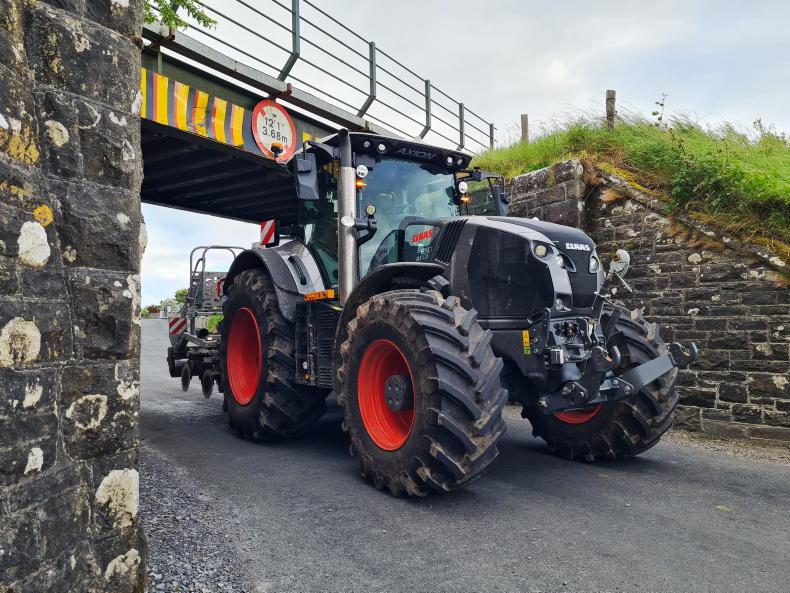
Axion engine oil service intervals are now gone to 600 operating hours, while transmission and hydraulic oil intervals have been extended to 1,200 hours.
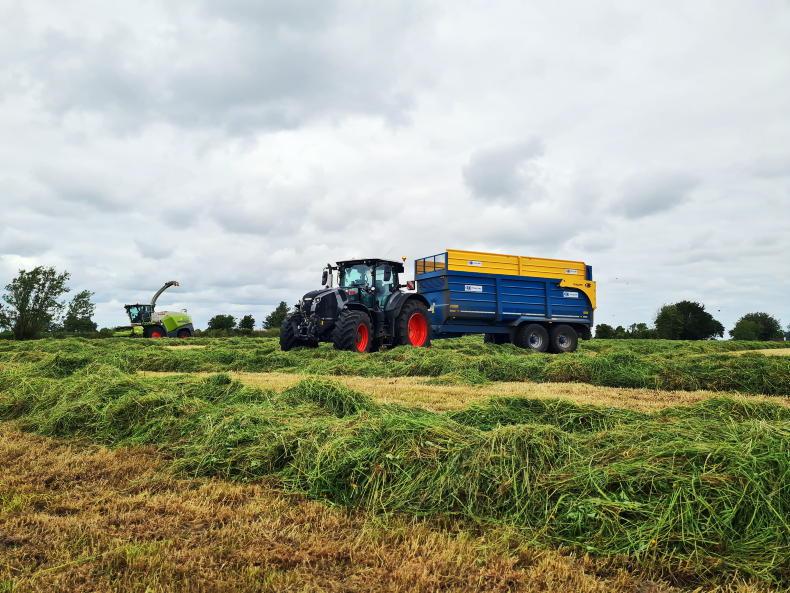
A cruise control option on the transmission allows speeds to be saved for all the ranges while on the move, by simply pressing a button on the drive lever.
Similar to the transmission, the level of customisation Claas offered with its hydraulics in terms of configuration was very impressive. Again, this is something higher horsepower tractor users now expect, but the biggest thing that impressed us again was the ease at which the hydraulics could be altered, whether it be moving the control of certain valves to the Cebis joystick or just altering flow rates on the move. All modifications are literally at the user’s fingertips, and could be configured in very little time. Something Claas has been offering for some time now is the pressure-release couplers. It’s simple, but a great feature when swapping implements.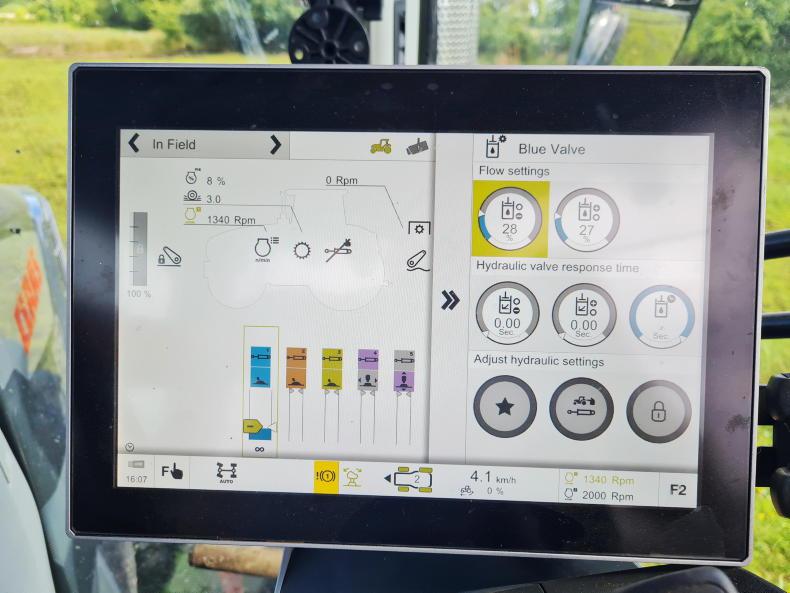
Similar to the transmission, the level of customisation Claas offered with its hydraulics in terms of configuration was very impressive.
New Cemis terminal
This tractor was one of the first to be fitted with the now widely available new Cemis 1200 terminal. This replaced the previous and outdated S10 universal terminal. The receiver and control technology used in the terminal was developed through a partnership with Trimble.
After initially appearing on the new Trion combine range, Claas has now added the option across its tractor, combine and forager ranges. In addition to the GPS Pilot automated steering, the new 12-inch terminal touchscreen handles online documentation for data transmission, IsoBus and task applications, section control (up to 80 sections) and variable rate application. The working areas and views for automated steering, site-specific quantity control and documentation can now be freely configured. It allows the import and export of work orders with reference tracks, field boundaries and activities in conjunction with a farm management program. In connection with telematics, work orders can be exchanged online.

The transmission has three speed ranges, each of which can be pre-selected in both directions of travel.

Our tractor had six electronic spools, while up to seven electronic spool valves can be specified on the armrest.
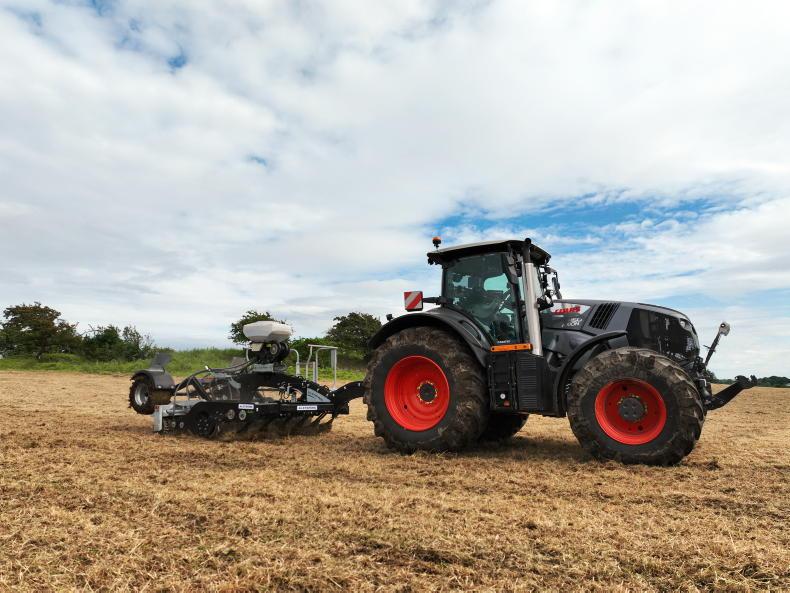
Similar to the transmission, the level of customisation Claas offered with its hydraulics in terms of configuration was very impressive.
Having used the unit, it’s sharp and crisp, and in our opinion is a breath of fresh air in comparison to the previous S10. Why? Well, the S10 was introduced 10 years ago, and although it offered quite a few of the same functionalities as its replacement, its operating system had become outdated. For example, it required a USB for data transfer. In recent years, it had been left behind by other systems available on the market.
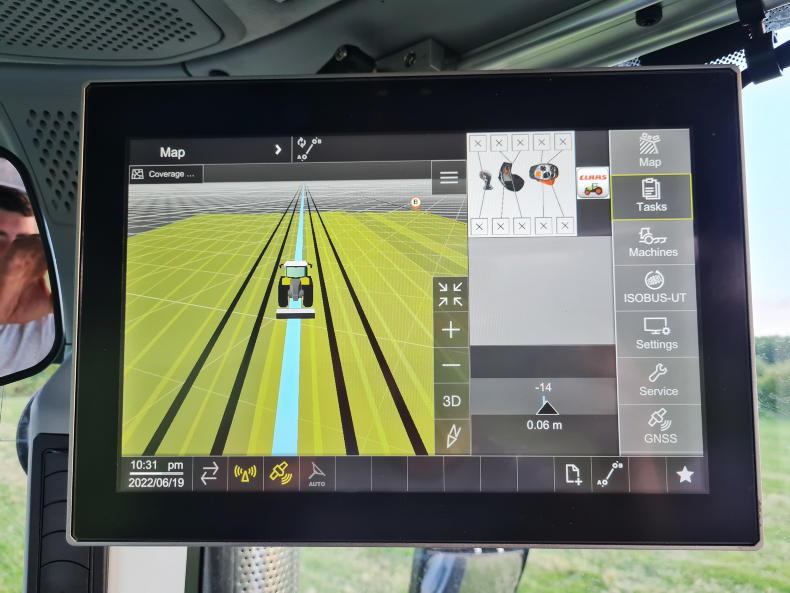
The 850 featured the new Cemis 1200 terminal, which has replaced the previous outdated S10 universal terminal.
Styling
This particular tractor is fitted with the manufacturer’s ‘Special Operation Centre’ package, which is a special order from factory. Features included in this package include the gunmetal grey paint finish, an upgraded cab sound system with Apple CarPlay, an interior airline, air horns, strobe lights and other customised features, such as a chrome exhaust stack, chrome bonnet decals, tinted rear windows, a floor carpet, a leather steering wheel, a number plate surround and a drivers kit.
This package really finishes off the tractor, giving it a proper premium feel. However, this feel will set you back an additional €7,000 plus the VAT.
For a big tractor, it was surprisingly mobile. When we spoke to Claas about this, they explained the chassis is designed like a wasp’s waist.
The front chassis is shaped to provide space for a large cooling pack above the front axle. Meanwhile, in front and behind it is designed to be narrow, for a small turning circle.
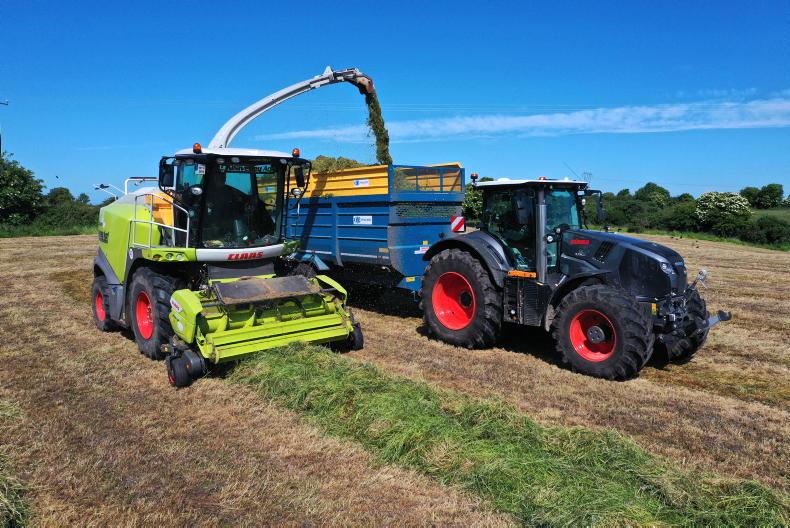
The transmission has three working modes- the accelerator pedal, the drive lever and manual mode.
Claas’s latest variation of its Axion series really impressed us. The tractor proved to be powerful and silent in acceleration, yet smooth in deceleration, but always offered a fast response to changes.
The biggest thing that took us by surprise with the tractor was the level of configuration available, and the ease of carrying out this configuration through the touchscreen Cebis terminal. All modifications, whether it be for the transmission, the hydraulics or even the linkages, are literally at your fingertips and very quickly performed through a small sequence of steps, just like operating your mobile phone. This is an area where many manufacturers have fallen down in the past, but the Claas system is very intuitive.
This tractor was one of the first fitted with the new Cemis 1200 terminal. Replacing the previous outdated S10 terminal, this feature alone seems to have leap-frogged the tractor forward by years. The comfort and styling of the premium package cab is like a breath of fresh air to drivers.
Overall, we were very impressed with the tractor. Its responsiveness, comfort and configuration abilities combined with the injection of modern technology demonstrates the effort that Claas is putting into its higher horsepower offerings to become a real competitor in the market.
Model: Axion 850 Cmatic.
Engine: 6.7l FPT engine.
Horsepower: 264hp.
Transmission: Cmatic CVT ZF transmission.
Hydraulics: 205 l/min LS hydraulic pump.
Spool valves: five rear spools, one front (up to seven combined).
Tyres: 710/70 r42/600/70 r30 Trelleborg.
List price: Axion 850 Cmatic pricing starts at €235,000.
Synonymous with machinery for harvesting grass and cereals for many years, Claas has been making solid inroads into the tractor business, particularly over the course of the past decade.
This stemmed from a move in February 2003, over 20 years ago, when Helmut Claas signed an agreement which saw Claas acquire the Renault Agriculture tractor brand.
Since then, the company has progressed in leaps and bounds, building in the region of 220,000 tractors including its Xerion range. Today, the firm manufactures up to 75 tractors daily, across 105 models from 75hp to 460hp at the Le Mans plant in France. These tractors are exported to over 80 countries worldwide, meaning Claas is becoming a big player in the market.

With 264hp neatly tucked away under the one-piece bonnet, the 850 sources power from a six-pot, 6.7l FPT engine.
Within the past few years, competition in the high horsepower tractor market has really heated up. We have seen complete revamps and new variations from a whole host of manufacturers, whether it be the new Fendt 700 series, John Deere’s 6R and 7R, Massey Ferguson’s 8S, Valtra’s Q Series, JCB’s iCON, Case IH’s Puma 260 CVX Drive or New Holland’s new T7.300 to name but a few. Keen to showcase its latest wares, Claas offered us the opportunity to get behind the wheel of a top spec Claas Axion 850 Cmatic over the summer months.
The 850 sources power from a six-pot, 6.7 litre FPT (Fiat Powertrain Technologies) NEF 6 engine. With 264hp neatly tucked away under the one-piece bonnet, the engine meets the Stage V emission standards by incorporating exhaust gas aftertreatment with AdBlue. The engine uses common rail four-valve technology, charge-air cooling and a variable geometry turbo (VGT). Claas claims that the VGT turbo adjusts to load and engine speed, making 70% of maximum torque available when idling.
Axion engine oil service intervals have now gone to 600 operating hours, while transmission and hydraulic oil intervals have been extended to 1,200 hours. Key maintenance points across the tractor seem to be quite easily accessible. The hood opens up high, allowing easy access to the engine compartment. The cooling pack opens out in a two-stage folding process, making it easy for the operator to thoroughly blow out around the radiator.

The combination of the engine and the CVT transmission in sync offered responsive and powerful acceleration and smooth deceleration.
In transport work, the engine felt very responsive. The tractor pulled away heavy loads, pushing to a top speed of 56km/h very quickly, while making very little fuss. In fact, top speed is hit at an engine speed of just 1,600 rpm, while 40 km/h is achieved at 1,300 rpm.
The combination of the engine and the continuously variable transmission (CVT) in sync offered responsive and powerful acceleration and smooth deceleration. The engine wasn’t left wanting power, and torque seemed to be on hand at low engine rpm.
Cmatic is the name Claas uses for the CVT used in its tractor ranges. In its Arion 500 and 600 Cmatic tractor series, the German manufacturer uses its own in-house manufactured EQ (EQ 200 and EQ 220) stepless transmissions. In the larger Axion 800 series we tried, the firm uses a ZF Terramatic transmission. However, it is believed that a larger stepless transmission is in development in-house and it is only a matter of time before it’s unveiled.
With the ZF transmission, the hydraulic mechanical split-power CVT features four mechanical ranges that are automatically selected by multidisc clutches. This means there is no need to shift between ranges manually, as it’s selected automatically each time.
The transmission has three working modes – the accelerator pedal, the drive lever and manual mode. In the first two modes, forward speed can be controlled by the accelerator pedal or drive lever. The engine speed and transmission ratio are adjusted automatically. In manual mode, it’s up to the driver to choose the engine speed and transmission ratio.

This particular tractor is fitted with the manufacturers ‘Special Operation Centre’ package, which is a special order from factory.

The 850 we put through her paces was spec’d with the largest 205 l/min pump available.

The biggest thing that took us by surprise with the tractor was the level of configuration available, and the ease of carrying out this configuration through the touchscreen Cebis terminal.
The transmission has three speed ranges, each of which can be pre-selected in both directions of travel. Operators can very easily set upper preset speed restrictions within each range. This is very simply done, by just touching the speeds on the terminal and increasing/decreasing to the desired target. The active range is then displayed on the Cebis terminal in green, while the other two ranges sit in the background in grey. The ranges can then be changed while the tractor is on the go.
A cruise control option on the transmission allows speeds to be saved for all the ranges while on the move, by simply pressing a button on the drive lever. The cruise control speeds can be easily pre-set. Drivers can also create their own profiles according to the job in hand.
Again, through the terminal, operators can easily make adjustments to the engine droop value. It can be used for easy regulation of the engine speed under load. The Cebis terminal displays the engine speed at which the transmission reduces the speed. For work such as PTO applications where a constant engine speed is activated, the operator can specify different droop settings, usually one that matches the engine speed to the required PTO speed. Two engine droop values can be saved and retrieved. 
The ease of tweaking the transmission through the Cebis terminal to get the most out of the tractor and implement at hand really impressed us.
Customising the transmission
This was our first time properly getting to grips with the Claas Cmatic CVT system. It took a few hours to get used to it at first, but once accustomed, we were seriously impressed. You could literally jump on and drive after a few hours. Although the level of customization Claas offers is now almost expected among CVT buyers, it was the ease of tweaking the transmission to get the most out of the tractor and implement at hand that really impressed us. All modifications are at your fingertips, and are very easily and quickly performed through a small sequence of steps.
Claas are pushing several aspects of this transmission. Firstly, because all mechanical range changes happen automatically, with no operator input. This means the operator is safe in the knowledge that no matter the speed, the transmission will select the correct range itself.
To back up this statement, the manufacturer is now offering a 4,000-hour or four-year warranty on all 800 series Axions sold with a Cmatic transmission.
CVTs are known to be slightly more power hungry, but manufacturers will tell you this is made up for with the transmissions’ increased efficiency. Claas claims its offering always maintains a 60% mechanical drive from the transmission, meaning a maximum of 40% is sourced from the hydraulic aspect. This is important, as mechanical drive offers a better efficiency. 
The tractor featured the Cebis controls, which includes the multifunction control lever and the 12" touchscreen terminal.
The 850 we put through her paces was spec’d with the largest 205 l/min pump available. All Axion 800 models come with the option of 110, 150 or 205 l/min output, all with load-sensing hydraulics. The pump provided ample hydraulics and was never left wanting from any task we tried it at.
Our tractor had six electronic spools, five on the rear and one on the front. On the Cebis terminal, up to seven electronic spool valves (front/rear combined) can be specified on the armrest, four of which can be operated by the Electropilot joystick.

Axion engine oil service intervals are now gone to 600 operating hours, while transmission and hydraulic oil intervals have been extended to 1,200 hours.

A cruise control option on the transmission allows speeds to be saved for all the ranges while on the move, by simply pressing a button on the drive lever.
Similar to the transmission, the level of customisation Claas offered with its hydraulics in terms of configuration was very impressive. Again, this is something higher horsepower tractor users now expect, but the biggest thing that impressed us again was the ease at which the hydraulics could be altered, whether it be moving the control of certain valves to the Cebis joystick or just altering flow rates on the move. All modifications are literally at the user’s fingertips, and could be configured in very little time. Something Claas has been offering for some time now is the pressure-release couplers. It’s simple, but a great feature when swapping implements.
Similar to the transmission, the level of customisation Claas offered with its hydraulics in terms of configuration was very impressive.
New Cemis terminal
This tractor was one of the first to be fitted with the now widely available new Cemis 1200 terminal. This replaced the previous and outdated S10 universal terminal. The receiver and control technology used in the terminal was developed through a partnership with Trimble.
After initially appearing on the new Trion combine range, Claas has now added the option across its tractor, combine and forager ranges. In addition to the GPS Pilot automated steering, the new 12-inch terminal touchscreen handles online documentation for data transmission, IsoBus and task applications, section control (up to 80 sections) and variable rate application. The working areas and views for automated steering, site-specific quantity control and documentation can now be freely configured. It allows the import and export of work orders with reference tracks, field boundaries and activities in conjunction with a farm management program. In connection with telematics, work orders can be exchanged online.

The transmission has three speed ranges, each of which can be pre-selected in both directions of travel.

Our tractor had six electronic spools, while up to seven electronic spool valves can be specified on the armrest.

Similar to the transmission, the level of customisation Claas offered with its hydraulics in terms of configuration was very impressive.
Having used the unit, it’s sharp and crisp, and in our opinion is a breath of fresh air in comparison to the previous S10. Why? Well, the S10 was introduced 10 years ago, and although it offered quite a few of the same functionalities as its replacement, its operating system had become outdated. For example, it required a USB for data transfer. In recent years, it had been left behind by other systems available on the market.

The 850 featured the new Cemis 1200 terminal, which has replaced the previous outdated S10 universal terminal.
Styling
This particular tractor is fitted with the manufacturer’s ‘Special Operation Centre’ package, which is a special order from factory. Features included in this package include the gunmetal grey paint finish, an upgraded cab sound system with Apple CarPlay, an interior airline, air horns, strobe lights and other customised features, such as a chrome exhaust stack, chrome bonnet decals, tinted rear windows, a floor carpet, a leather steering wheel, a number plate surround and a drivers kit.
This package really finishes off the tractor, giving it a proper premium feel. However, this feel will set you back an additional €7,000 plus the VAT.
For a big tractor, it was surprisingly mobile. When we spoke to Claas about this, they explained the chassis is designed like a wasp’s waist.
The front chassis is shaped to provide space for a large cooling pack above the front axle. Meanwhile, in front and behind it is designed to be narrow, for a small turning circle.

The transmission has three working modes- the accelerator pedal, the drive lever and manual mode.
Claas’s latest variation of its Axion series really impressed us. The tractor proved to be powerful and silent in acceleration, yet smooth in deceleration, but always offered a fast response to changes.
The biggest thing that took us by surprise with the tractor was the level of configuration available, and the ease of carrying out this configuration through the touchscreen Cebis terminal. All modifications, whether it be for the transmission, the hydraulics or even the linkages, are literally at your fingertips and very quickly performed through a small sequence of steps, just like operating your mobile phone. This is an area where many manufacturers have fallen down in the past, but the Claas system is very intuitive.
This tractor was one of the first fitted with the new Cemis 1200 terminal. Replacing the previous outdated S10 terminal, this feature alone seems to have leap-frogged the tractor forward by years. The comfort and styling of the premium package cab is like a breath of fresh air to drivers.
Overall, we were very impressed with the tractor. Its responsiveness, comfort and configuration abilities combined with the injection of modern technology demonstrates the effort that Claas is putting into its higher horsepower offerings to become a real competitor in the market.
Model: Axion 850 Cmatic.
Engine: 6.7l FPT engine.
Horsepower: 264hp.
Transmission: Cmatic CVT ZF transmission.
Hydraulics: 205 l/min LS hydraulic pump.
Spool valves: five rear spools, one front (up to seven combined).
Tyres: 710/70 r42/600/70 r30 Trelleborg.
List price: Axion 850 Cmatic pricing starts at €235,000.





















 This is a subscriber-only article
This is a subscriber-only article




















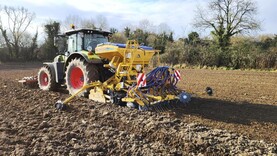
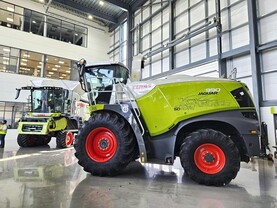
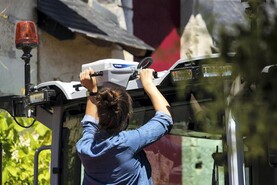

SHARING OPTIONS: